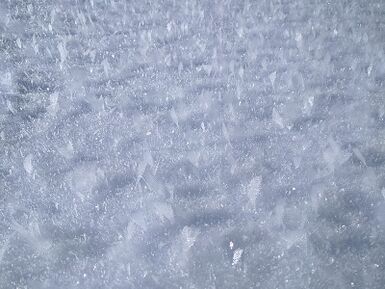Hoar frost

Hoar frost refers to white ice crystals deposited on the ground or loosely attached to exposed objects, such as wires or leaves. [2]
When surface hoar covers sloping snowbanks, the layer of frost crystals may create an avalanche risk; when heavy layers of new snow cover the frosty surface, furry crystals standing out from the old snow hold off the falling flakes and forming a layer of voids that prevents the new snow layers from bonding strongly to the old snow beneath. [3]
Ideal conditions for hoarfrost to form on snow are cold, clear nights when conditions are such that heat radiates out to the open air faster than it can be replaced from nearby sources, such as wind or warm objects. [4] Nocturnal hoarfrost forms if the sky is dry and clear, the winds are near calm, the surface has a high radiative emissivity, and surfaces are oriented with a view factor to the sky. This requires a sky radiative temperature that is lower than the frost point, which is common during the winter. Winds should be nearly calm to prevent the heat lost to radiation from being rapidly replaced by convection. Objects need to be oriented towards the sky for maximum cooling. [5]
In very low temperatures where fluffy surface hoar crystals form without subsequently being covered with snow, strong winds may break them off, forming a dust of ice particles and blowing them over the surface. Hoar frost and white frost also occur in man-made environments such as in freezers or industrial cold-storage facilities.
References
- ↑ James Heilman, MD. https://commons.wikimedia.org/wiki/user:Doc_James. Wikimedia commons. Hoar frost. Creative Commons Attribution-Share Alike 4.0 International license.
- ↑ "Hoarfrost – Definition of hoarfrost by Merriam-Webster". merriam-webster.com. Archived from the original on 2015-02-19.
- ↑ David McClung; Peter A. Schaerer (2006). The Avalanche Handbook. The Mountaineers Books. pp. 72–. ISBN 978-0-89886-809-8. Archived from the original on 2016-05-06.
- ↑ Louisiana State University Baton Rouge Robert V. Rohli; Robert V. Rohli; Anthony J. Vega (13 December 2013). Climatology. Jones & Bartlett Publishers. pp. 381–. ISBN 978-1-284-05427-9. Archived from the original on 19 May 2016.
- ↑ Charles C. Ryerson. April 2013. Icing Management for Coast Guard Assets. Cold Regions Research and Engineering Laboratory. ERDC/ C R R E L TR-13-7.
- ↑ Wikipedia. https://en.wikipedia.org/wiki/Frost#Hoar_frost